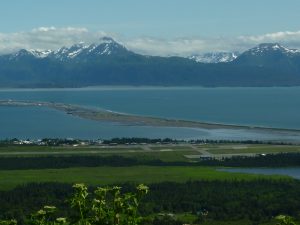Photo by Jeanne Deloach
Glistening sunshine reflecting off the water, eagles soaring high in the blue sky and beautiful sea life, – just the normal scene at the fabulous spit tourists and Homer citizens alike look forward to seeing.. But it was not always like this. The town used to exist only on the area of the spit. It began to expand and thrive until the 1964 earthquake hit and caused mass destruction across the state.
Ryjil Christianson, an educator at the Pratt Museum referred to the spit as Homer’s, “main economic engine.”
Before Homer became a city, its main use was for coal mining until Homer Pennock tried to promote gold mining. Although people still mined coal more, mining’s popularity had risen to the point where a railroad was built from Bishops Beach out to the spit. The area of Homer wished to establish a post office, and in order to accomplish that, the area needed to become a city and have a name. Many miners gathered and decided to name the city after Mr. Homer Pennock. The residents of Homer continued building by constructing a harbor on the spit which they did previous to the official establishment as a city. Salty Dawg Saloon is believed to be the oldest building, and the first in the town. Other significant buildings included general stores, two restaurants, South Peninsula Hospital, Lands End, and the Homer Electric Association (HEA) according to the city of Homer website.
The green forest timbers, native flowers, and wide spit wouldn’t last much longer. The 1964 earthquake, also known as the Good Friday earthquake, caused catastrophe across Homer with a magnitude of 9.2 according to The Alaska Earthquake Information Center. Most buildings started falling apart and many were completely demolished. In 240 seconds the spit was in ruins.
“It was in danger of becoming an island.” Christianson said.
Tectonic subsidence impacted the new size of the spit with a seven foot drop in useable land due to the sinking of the earth’s crust. Five feet are a result of sand compacting while the other two feet are due to the tectonic subsidence effects. The city began a massive clean-up and reconstruction effort.
Rebuilding took work, and money the state helped supply since Homer had established itself as a city before the earthquake. The harbor was rebuilt with some of the money according to the City of Homer website. Salty Dawg moved after the quake to its current location. To save the spit from the danger of possibly becoming an island, not only were the roads rebuilt, but also they were raised up above sea level. Furthermore, the large boulders that can be spotted on a walk or drive around the spit were brought in by work crews, Christianson explained. The spit has come a long way and is going strong.
Today the spit busts with traffic of tourists from cruise ships, bus tours and even campers. It has expanded greatly, with charters, restaurants, beaches, wildlife and more.

